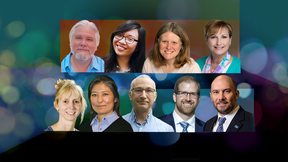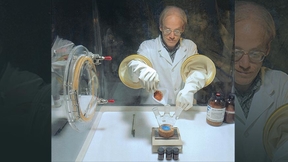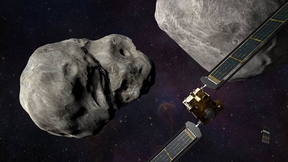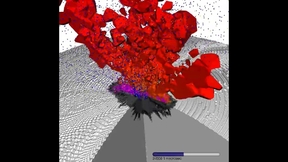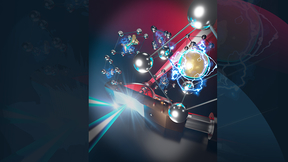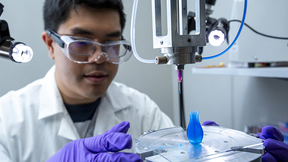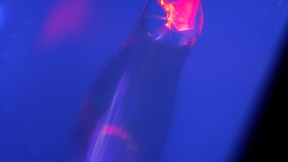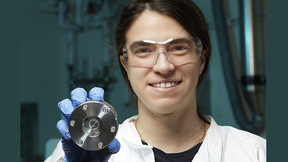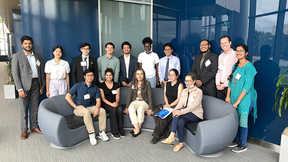Back
It could be called better understanding through chemistry. An international research team including Lawrence Livermore National Laboratory (LLNL) scientists has succeeded in gaining new insights into the chemical properties of the superheavy element flerovium — element 114. The measurements, taken at the at the accelerator facilities of the GSI Helmholtzzentrum für…
The last nuclear test, code-named Divider, took place 30 years ago, on Sept. 23, 1992. That year, President Bush declared a temporary moratorium on nuclear testing, which became permanent during the Clinton administration. This ending of the era of nuclear testing was also the beginning of stockpile stewardship. Leaders from the Department of Energy (DOE), and Lawrence…
Scientific discovery during the Stockpile Stewardship Program maintains confidence in the nuclear deterrent without testing, brings other benefits The last nuclear test, code-named Divider, took place 30 years ago, on September 23, 1992. That year, President Bush declared a temporary moratorium on nuclear testing, which became permanent during the Clinton administration…
The last nuclear test, code-named Divider, took place 30 years ago, on Sept. 23, 1992. That year, President Bush declared a temporary moratorium on nuclear testing, which became permanent in 1995, during the Clinton administration. This ending of the era of nuclear testing coincided with a Presidential announcement of the beginning of stockpile stewardship. As the decision…
Today at 4:14 p.m. (PDT), NASA’s Double Asteroid Redirection Test (DART) Mission will execute the first-ever asteroid-deflection test by crashing into asteroid Dimorphos. Traveling at ~6 km/s with a mass of ~600 kg, the DART spacecraft will transfer enough momentum for the imparted change in velocity to be detectable from Earth-based telescopes. However, there is…
An international team including a researcher from Lawrence Livermore National Laboratory (LLNL) has determined that one specific particle on the asteroid Ryugu can shed light on the unaltered initial materials from its parent body. In December 2014, the Japanese Aerospace Exploration Agency launched the spacecraft Hayabusa2 to the asteroid 162173 Ryugu. In December 2020,…
NASA’s Double Asteroid Redirection Test (DART) spacecraft will crash into asteroid Dimorphos on Sept. 26, executing the first asteroid deflection test that has been years in the planning. Dimorphos, at 150 meters across, is the “moonlet” of a binary asteroid system, orbiting the larger companion asteroid, Didymos (800 meters). The momentum of the ~600 kg spacecraft,…
Investigating how solid matter behaves at enormous pressures, such as those found in the deep interiors of giant planets, is a great experimental challenge. To help address that challenge, Lawrence Livermore National Laboratory (LLNL) researchers and collaborators took a deep dive in understanding these extreme pressures. The work was just published in Nature Physics with…
Lawrence Livermore National Laboratory (LLNL) researchers and their collaborators have developed new high-energy pulse compression gratings that will be used in the world’s highest-power laser system, designed to deliver up to 10 petawatts (quadrillion watts) of peak power. A petawatt is about 1,000 times the capacity of the entire U.S. electric grid. The high-energy, low…
Lawrence Livermore National Laboratory (LLNL) scientist Alison Ruth Christopherson has earned the American Physical Society’s (APS) Marshall N. Rosenbluth Outstanding Doctoral Thesis award. The award recognizes exceptional early-career scientists who have performed original thesis work of outstanding scientific quality and achievement in the area of plasma physics…
The Burning Plasma Team has been awarded the 2022 John Dawson Award for Excellence in Plasma Physics Research by the American Physical Society. The team consists of members from Lawrence Livermore National Laboratory (LLNL) and from other institutions. The team was cited “for the first laboratory demonstration of a burning deuterium-tritium plasma where alpha heating…
Red dwarfs are the most abundant stars in the Milky Way, making up 70% of all stars. But the physics of their interiors is not well understood. Heat is generated in the core and travels outward to the surface, but it is not clear whether that process occurs via radiation, convection or a combination of the two. The key factor determining whether red dwarfs are radiation-…
Lawrence Livermore National Laboratory (LLNL) hosted a group of students and faculty from Historically Black Colleges and Universities (HBCUs) for a week in June to promote internships, job opportunities and career paths at LLNL. Judging from the group’s reaction and feedback, the inaugural week-long HBCU tour was a clear success and made a positive impression on the…
Lawrence Livermore National Laboratory (LLNL) scientists and engineers have garnered three awards among the top 100 industrial inventions worldwide. The trade journal R&D World Magazine recently announced the winners of the awards, often called the “Oscars of invention,” recognizing new commercial products, technologies and materials that are available for sale or…
The synthesis and study of radioactive compounds are naturally difficult due to the extreme toxicity of the materials involved, but also because of the cost and scarcity of research isotopes. Now, Lawrence Livermore National Laboratory (LLNL) scientists and their collaborators at Oregon State University (OSU) have developed a new method to isolate and study in great detail…
The High Performance Computing for Energy Innovation (HPC4EI) initiative will hold a special webinar on Oct. 7 to celebrate Manufacturing Day and provide a forum for industry experts and Department of Energy (DOE) scientists to discuss how HPC can help combat climate change and improve energy efficiency. The virtual event begins at 8 a.m. PDT and brings together panelists…
No need to worry, it is just a very small piece for scientific study. In December 2014, the Japanese Aerospace Exploration Agency launched the spacecraft Hayabusa2 to the asteroid 162173 Ryugu. In December 2020, when the sample-return capsule successfully landed safely back on Earth with pristine pieces of Ryugu that it had collected, Lawrence Livermore National Laboratory…
Leaders at Lawrence Livermore National Laboratory (LLNL) and the Korea Institute of Science and Technology (KIST) signed a memorandum of understanding (MOU) on Monday to collaborate on basic science and technology in the renewable energy, climate science, data science and characterizations arenas. Under the MOU, KIST will have office space in the Livermore Open Campus…
The leaders of Case Western Reserve University and Lawrence Livermore National Laboratory (LLNL) signed a memorandum of understanding (MOU) to accelerate their efforts in shared areas of excellence. After three years of growing institutional collaboration in such areas as energy, materials science and polymer processing, Case Western Reserve President Eric W. Kaler…
Lawrence Livermore National Laboratory (LLNL) intern Jordan Stanberry is spending his summer examining pond sediments to better understand groundwater contamination from decades-old nuclear tests. A chemistry graduate student from the University of Central Florida (UCF), Stanberry is participating in an eight-week Glenn T. Seaborg Institute (GTSI) internship program. The…


